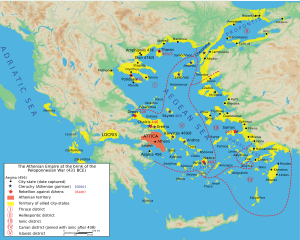Thirty Years' Peace facts for kids
The Thirty Years' Peace was an important agreement signed between two powerful ancient Greek city-states: Athens and Sparta. This treaty was made in 446 or 445 BC. Its main goal was to stop the fighting of the First Peloponnesian War, which had been going on since about 460 BC.
Why They Needed Peace
The main reason for the Thirty Years' Peace was to prevent another big war from breaking out. Sadly, the peace treaty did not fully succeed. A new, even bigger war, the Second Peloponnesian War, started in 431 BC.
As part of the treaty, Athens had to give up some lands it controlled in the Peloponnese region. These included the ports of Nisaea and Pagae near Megara, along with Troezen and Achaea in Argolis. However, Sparta agreed that Athens could keep the city of Naupactus.
The treaty also said that Sparta and Athens should not fight each other directly if one of them wanted to solve a problem through "arbitration." Arbitration means having a neutral third party help settle a disagreement. Cities that were not allied with either side could choose to join Athens or Sparta. This shows that both sides had official lists of their allies. Athens and Sparta would keep all other lands they controlled until any disputes were settled by arbitration. The treaty also officially recognized both the Athenian and Spartan alliances, which was a big win for Athens and its growing empire.
However, this peace only lasted for fifteen years. It ended when Sparta declared war on Athens. During the peace, Athens took actions that seemed to break the truce. For example, in 435 BC, Athens got involved in a dispute over the cities of Epidamnus and Corcyra. This made the Corinthians, who were allies of Sparta, very angry. Athens also put trade restrictions on Megara, another Spartan ally, because Megara was involved in the dispute between Corinth and Corcyra. In 432 BC, Athens attacked Potidaea. Potidaea was listed as an Athenian ally, but it was also a colony of Corinth. These disagreements led Sparta to declare that Athens had broken the treaty. Sparta then declared war, ending the Thirty Years' Peace and starting the Second Peloponnesian War.
The Samian Rebellion Test
The Thirty Years' Peace faced its first big challenge in 440 BC. This happened when Samos, a strong ally of Athens, rebelled against Athens. The rebels quickly got help from a Persian governor. This meant Athens faced the risk of many other cities in its empire also rebelling. If Sparta had decided to step in at that moment, they could have easily defeated Athens, which was in a very weak position. But when the Spartans held a meeting to discuss going to war, they decided not to. The city of Corinth, a key Spartan ally, was especially against going to war with Athens at that time.
Trouble with Corcyra and Corinth
The conflict between Corcyra and Corinth caused big problems for the peace treaty. It was one of the main reasons the Thirty Years' Peace ended and the Peloponnesian War began. The argument was over a small, distant land called Epidamnus.
Corcyra went to Athens to ask for help. They argued that there were only three major navies (fleets of warships) in Greece: Athens's, Corcyra's, and Corinth's. Corcyra warned Athens that if Corinth gained control of Corcyra's navy, then Athens would have to fight against two strong navies at once: Corinth's and Corcyra's, both part of the Peloponnesian side. However, if Athens helped Corcyra, then Athens could fight the Peloponnesian forces with the help of Corcyra's navy.
Corinth argued back that while the treaty said cities not allied with anyone could join either side, this rule was not meant for cities joining just to hurt the other side.
Athens decided to form a defensive alliance (called epimachia) with Corcyra. This was unusual because most alliances at the time were both offensive and defensive (called symmachia). This defensive alliance was the first of its kind known. This decision led to war with the Corinthians. The Battle of Sybota was one of the battles that came from this conflict. The Athenians were forced to fight the Corinthians, which further damaged the peace treaty.



